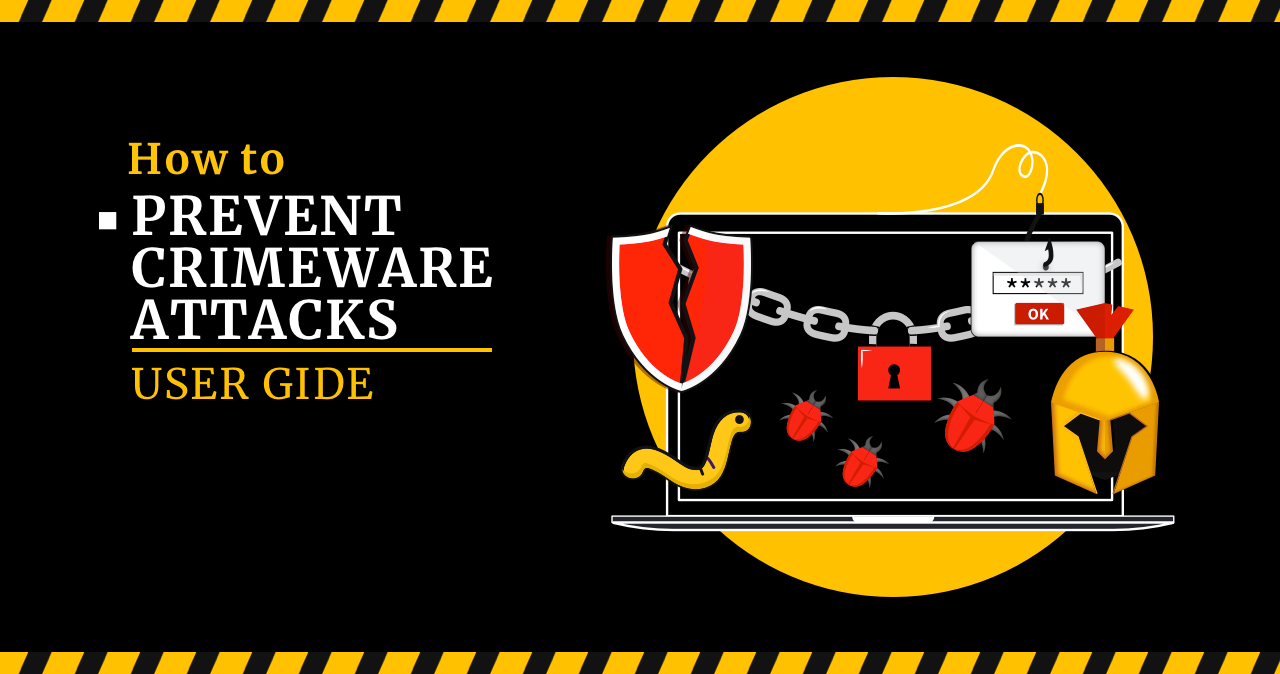You may come across the term “Crimeware” and understandably get confused as you probably thought before that only malware or viruses are the words for the definition of any bad intention malware.The term “Crimeware” doesn’t mean another synonym for malware or viruses but rather it is a standalone word for specific kind of malware which is designed to automate cybercrime.
The term was created by David Jevans in February 2005 when he mentioned the word in his response to the FDIC article “Putting an End to Account-Hijacking Identity Theft”. The article to which Jevans made a response was published on December 14, 2004.
How Does Crimeware Work
The typical victims of crimeware usually become companies and users who store some valuable and important information. For example, health care providers have become one of the main targets of crimeware in recent years and largely due to the COVID-19 pandemic the number of this kind of cyber attacks has risen.
Crimeware also doesn’t mean a specific kind of software or viruses but rather it employs a wide range of different malicious programs and software to facilitate cybercrimes. Crimeware can use adware, spyware, worms, Trojan horse programs or viruses to spread and perpetrate crime like stealing proprietary information, money or personal identities.
Among the various techniques cybercriminals can implement and thus successfully conduct their cyber attacks are the next kinds of methods:
- Cybercriminals encrypt all the data on victim’s computer and then will try to extort some sum of money demanding ransom payment to be paid (Ransomware);
- Get a hold of remote access into applications that should later allow cybercriminals to get an access to networks for further malicious actions;
- Break into a user’s session at some financial institution to completely drain the available funds without users knowledge for that;
- Steal all available passwords on that is cached on a user’s system;
- Pharming — a method when cybercriminals with intent redirect user’s search in a web browser for a specific domain in an address bar to their counterfeit one that is also controlled by them;
- Install keystroke loggers in order to try to collect sensitive and valuable information like login and password information for bank accounts. Once the malicious program has done the job it will report the results back to the cybercriminal.
How Crimeware Spreads
To install crimeware on victim’s computer cybercriminals can use the next possible delivery vectors:
- Remote exploit vulnerabilities found in clients and servers. RCE vulnerabilities allow cybercriminals to execute their own arbitrary code on a remote device;
- Social engineering via email. In this delivery vector cyber criminals specifically tailor their malicious emails so that there will be high chance that a victim might click on malicious attachment or link and allow crimeware to be executed;
- Vulnerabilities that are found in different web applications. For example, it is known that cybercriminals have exploited one of such vulnerabilities, the Bankash.G Trojan that allowed them to monitor user’s input in webmail and online commerce sites also stealing passwords.
What Are Consequences Of Crimeware Attack
In particular cases crimeware attacks can have serious results both for companies and individuals. More likely victims will lose money, valuable information, intellectual property. In other cases the consequences might also be:
- Identity theft. This cybercrime involves the stealing of someone’s personal information to further commit some type of fraud;
- Loss of productivity. If a user gets infected with crimeware they will experience not only its direct infection consequences but also their computer will suffer on its part. User’s device may experience system slowdowns, numerous errors in operating system and other kinds of productivity loss;
- The potential loss of data. When, for example, cybercriminals use ransomware to conduct their malicious actions then one of several possibilities a victim may experience from this kind of crimeware attack is the loss of data.
This is especially true if victim refuses to pay and it’s what many law enforcement agencies advise to do because ransom payments only add reimbursement to now ever growing ecosystem of cybercrime and so allow cybercriminals to further conduct crimes; - Financial loss because of stolen passwords. If a cyber criminals manage to get password, for example, to your bank account you risk that your money will be stolen or cybercriminals may use the stolen credentials to some of your shopping websites’ accounts and make an order but changing address;
- Data theft. In another way it is called information theft and this kind of crimeware attack usually happens on corporate servers, devices, databases. Data theft is particularly dangerous for businesses of all sizes and it can come both from within and outside a company;
- Intrusion of privacy. In the cyber security field the words refer to an unauthorized activity on a digital network. In the cyber crime attack criminals try to steal various valuable network resources and as a result the security of the whole network and the data is at risk.
How To Prevent Crimeware Attacks
It would be impossible to stop cybercriminals from attacking you but you can actually take several steps to make the risks lower and chances of being attacked as well:
- Update your software regularly. The main vector by which cybercriminals can attack you is various vulnerabilities that can be found either in software you use or your device. Applying patches as soon as they get available significantly lowers the chances that you will be the next victim of crimeware;
- Don’t use an administrator account if there’s no need. Crimeware often tries to exploit such accounts because in case of a success it will give cybercriminals an immense range of rights to perform whatever they need to accomplish their malicious actions on your device;
- Enable email security and spam protection. Being the main communication channel for various businesses across the globe it is actively exploited by crimaware. Set a special settings that will ensure spam email filtering, scan for viruses and malware, limit access only to beforehand links, email addresses and messages;
- Enable secure authentication methods. Security authentication methods that should ensure no one could get unauthorized access to your device and data. These methods will include multi factor authentication, different biometrics tools, strong passwords and password manager;
- Use antivirus and antimalware software. They will scan your device to identify and remove any malware present thus ensuring you won’t leave cybercriminals with a chance to finish their malicious probe. Immediately attend to any malware detected and deal with it. Also, don’t forget to regularly run scans so that you will detect a threat in time.




